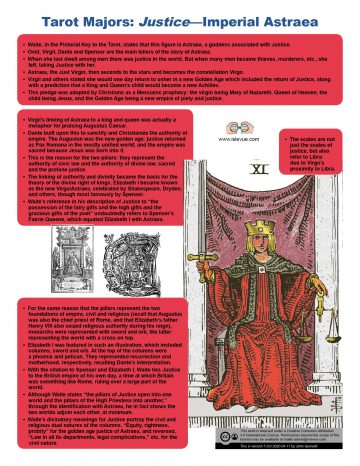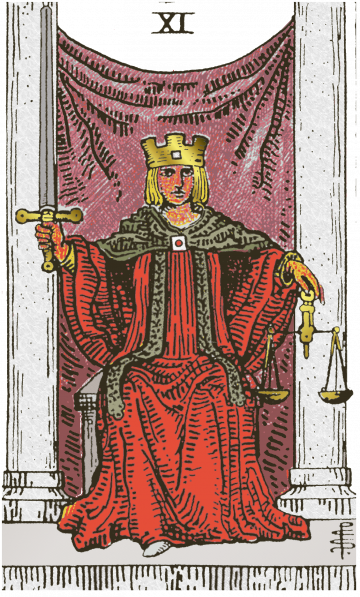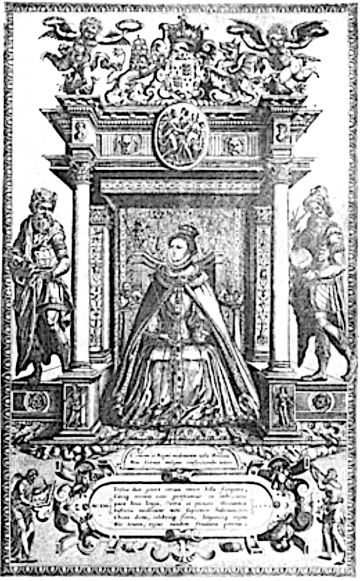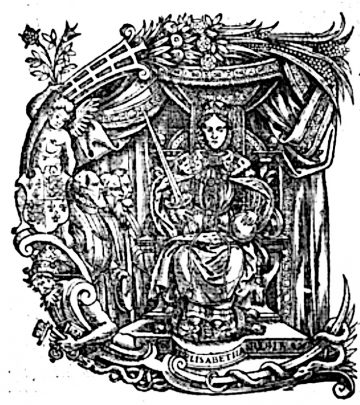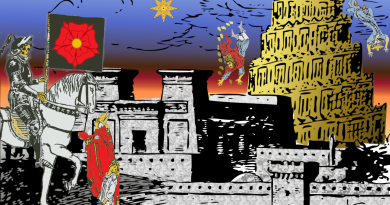Justice – Imperial Astraea
The classical virtue of Justice is much more about "fairness" than judicial or legal process. Plato, in The Republic, examines Justice from several different viewpoints which generally have to do with various parts of a whole working for or against each other vs. the interest of the whole, though in the end, it’s not clear that he finds a perfect definition. Wikipedia quotes Aristotle, who said it "consists in a certain equality by which the just and definite claim of another, neither more nor less, is satisfied."
At first glance, Waite and Colman Smith’s Justice arcanum appears to pay lip service to fairness, but at the end, it is more interested in the judicial/enforcement aspect of Justice. We see an authoritative figure with a big sword held high in her right hand, sitting on "the bench" in a court-like setting, having the appearance of being ready to declare judgement. Fairness is relegated to the small set of scales she holds with her left hand.
Astraea Has Left the Building
Waite is far clearer in naming his figure of Justice. He calls her "Astraea, who personified the same virtue and is represented by the same symbols." Astraea, the virgin goddess of justice was said to be the last of the gods who lived among men. Though most of the gods were said to have left after the golden age, she stayed on through the silver age, the bronze age and the age of heroes, leaving only when the iron age began. It was the injustice of the men of these times which drove her away.
But part of Astraea’s story is a prediction that she, and Justice will one day return to Earth, also bringing with her a new golden age.
It is by the linking of the Astraea story that we can understand that Waite seeks to show us the judicial trappings of the illustration are only the top layer. We must examine the story of Astraea, as told by Ovid, Virgil, Dante, Spenser and others. Importantly, the latter two poets superimposed a Christian context upon Astraea’s story.
Francis A. Yates, a twentieth century scholar wrote (Journal of the Warburg and Courtauld Institutes Vol. 10, 1947):
“There is, of course, another side to the fame of (Virgil’s) Fourth Eclogue. This paean to the golden age of empire was adapted by the Christians as a Messianic prophecy. The child whose advent it foretells becomes Christ, born during the reign of Augustus, beneath whose spiritual reign the iron brood of sin should first begin to fail and the golden age of Christian piety and justice should arise. And the virgin "who returns" becomes, not merely the virgin Astraea returning to earth in the new golden age of empire, but the Virgin Mary, Mother of God and Queen of Heaven, whose appearance with her divine son ushers in the Christian era.
Yates goes on to document that this linking of Empire and Justice eventually became the basis for the doctrine of the divine right of monarchy which peaked in the Renaissance, at the time when kings and queens surpassed even the power of the papacy. She cites political writers such as Erasmus, John Foxe, Antonio de Guevara and others, but identifies Dante as the one who started it all:
Dante’s treatment, therefore, tends very strongly to sanctify and Christianize the imperial idea. The just virgin is the sacred empire, justified in its own right because it produced the Augustan golden age when the world was most one, and justified by God because it was the fullness of time in which Christ chose to be born. The moon of empire borrows its light direct from the sun of God’s approval. The just virgin becomes an imperial virgin, sacred and divine.
We therefore have two main components. The first is the peace (golden age) that empire brings because it has conquered a large part of the world. Everyone knows that Augustus reigned during the Pax Romana. Elizabeth was said to reign during a "Pax Tudor" insofar as the long War of the Roses had ended. And Waite, of course, lived during a time some called a Pax Britannica, which though not particularly peaceful, was a time at which the sun was said never to set upon the British Empire. The second component is the spiritual one: the identification with some divinity who exemplifies Justice.
With this knowledge we can identify the two columns in Colman Smith’s illustration. One symbolizes the divine concept of justice, the other, the worldly (or profane) administration of human justice.
Of course, though we can trace how Astraea was portrayed as a renaissance era explanation for the divine right of kings—that is hardly what we would call justice today.
Let’s now examine the illustration in detail. Note: the next section is exactly the same as the PDF/graphic (it’s reprinted here as text mostly for the benefit of web indexers). If you’ve already read it, you can skip on to the concluding section, which will discuss how this affects the reading of the Justice arcanum in today’s world, as well as a few thoughts of my own regarding the virtue of Justice as it relates to the pandemic situation we find our society in at the time of this writing.
The Female Figure
- Waite, in the Pictorial Key to the Tarot, states that this figure is Astraea, a goddess associated with Justice.
- Ovid, Virgil, Dante and Spenser are the main tellers of the story of Astraea.
- When she last dwelt among men there was justice in the world. But when many men became thieves, murderers, etc., she left, taking Justice with her.
- Astraea, the Just Virgin, then ascends to the stars and becomes the constellation Virgo.
- Virgil and others stated she would one day return to usher in a new Golden Age which included the return of Justice, along with a prediction that a King and Queen’s child would become a new Achilles.
- This pledge was adopted by Christians as a Messianic prophecy: the virgin being Mary of Nazareth, Queen of Heaven, the child being Jesus, and the Golden Age being a new empire of piety and justice.
The Columns
- Virgil’s linking of Astraea to a king and queen was actually a metaphor for praising Augustus Caesar.
- Dante built upon this to sanctify and Christianize the authority of empire. The Augustan was the new golden age: justice returned as Pax Romana in the mostly unified world; and the empire was sacred because Jesus was born into it.
- This is the reason for the two pillars: they represent the authority of civic law and the authority of divine law, sacred and the profane justice.
- The linking of authority and divinity became the basis for the theory of the divine right of kings. Elizabeth I became known as the new Virgo/Astraea, celebrated by Shakespeare, Dryden, and others, though most famously by Spenser.
- Waite’s reference in his description of Justice to "the possession of the fairy gifts and the high gifts and the gracious gifts of the poet" undoubtedly refers to Spenser’s Faerie Queene, which equated Elizabeth I with Astraea.
The Sword
- For the same reason that the pillars represent the two foundations of empire, civil and religious (recall that Augustus was also the chief priest of Rome, and that Elizabeth’s father Henry VIII also seized religious authority during his reign), monarchs were represented with sword and orb, the latter representing the world with a cross on top.
- Elizabeth I was featured in similar illustrations, which included columns, sword and orb. At the top of the columns in one such illustration were a phoenix and pelican. They represented resurrection and motherhood, respectively, recalling Dante’s interpretation.
- With the citation to Spenser and Elizabeth I, Waite ties Justice to the British empire of his own day, a time at which Britain was something like Rome, ruling over a large part of the world.
- Although Waite states "the pillars of Justice open into one world and the pillars of the High Priestess into another," through the identification with Astraea, he in fact shows the two worlds adjoin each other, at minimum.
- Waite’s divinatory meanings for Justice portray the civil and religious dual natures of the columns. "Equity, rightness, probity for the golden age justice of Astraea, and reversed, "Law in all its departments, legal complications," etc. for the civil nature.
The Scales
- The scales are not just the scales of justice, but also refer to Libra due to Virgo’s proximity to Libra.
Conclusion
With the understanding of these symbols we can better see that Waite’s concept of the virtue of Justice is not only visually linked to authority in its outer aspects, but also in its symbolic content as well. With Waite’s reference to Spenser and Elizabeth I in particular, we must understand that the justice of the RWS deck is the justice of the authority of the crown as delegated it by the divine, fueled by the British nationalism that is a secondary theme of Waite’s tarot. It is societal justice, and in particular, the notion of justice held by one particular part of one particular society. Waite states it is deserved, as in this phrase included in his divinatory meanings "triumph of the deserving side in law." Waite’s Justice is the justice of the ruling class.
When we talk about the Justice card today, therefore, we should bear in mind that it is not necessarily an ideal concept; it probably has nothing to do with being "just."
The concept of Jusice held by ordinary people has ebbed and flowed markedly in the last century. The Nuremberg Tribunals and the U.S. civil rights movement broadened that concept. 21st century events following the "Pearl Harbor" style events of the 2001 World Trade Center demolition, the 2008 banking crisis and the 2020 CV19 pandemic have narrowed that concept.
I fear the common peoples of the world will need another virtue, Strength, to survive these times. Justice fell victim to a hostile takeover, and Astraea will not be coming back soon.
Copyright Information: This article’s content by John Iacovelli, for islevue.com is licensed under a Creative Commons Attribution 4.0 International License. Permissions beyond the scope of this license may be available at mailto:admin@islevue.com.
This article’s content by John Iacovelli, for islevue.com is licensed under a Creative Commons Attribution 4.0 International License. Permissions beyond the scope of this license may be available at mailto:admin@islevue.com.
Francis A. Yates article excerpts Copyright © 1947, Warburg Institute. Note: you may currently find this online in the JSTOR database. At the current time fees are waived.
The Wikipedia articles’ copyrights are governed by the Creative Commons share-alike license.
Feature image background by Thomas Cole – Explore Thomas Cole, Public Domain, Link

